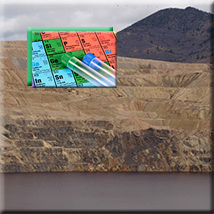Part 1: Chemical Structure. This section covers chemical structure from atomic to molecular scale. Concepts of polarity and electronegativity are introduced and interactions between molecules are discussed. The basic rules of chemical nomenclature are also reviewed.
Part 2: Chemical Properties. Several chemical properties are introduced that are relevant to chemical fate such as solubility and partitioning coefficients. Sources of data are discussed along with uncertainties.
Part 3: Chemical Contaminants. Major contaminant groups are discussed including metals and organic compounds. The relationship between metal speciation and properties is illustrated through example. Chemical structures for organic molecules are reviewed. The interplay between structure and properties is highlighted throughout.
Part 4: Chemical Reactions. This section introduces the concepts of chemical reactions and products. Acid-base and oxidation-reduction reactions are discussed in detail. The concepts of pH and pE are explained. Dissolution and partitioning reactions are also discussed.
Part 5: Characteristics of Subsurface Systems. The purpose of this section is to understand the meaning and magnitude of subsurface parameters required by groundwater contaminant transport models. Properties of subsurface systems and their impact on chemical transport are discussed.
Part 6: Contaminant Transport. Phenomena are discussed that influence the movement and fate of dissolved phase contaminants in groundwater. The impact of advection, dispersion, sorption, and chemical reactions are discussed in an incremental fashion.
Part 7: Nonaqueous Phase Liquids. In this section, the movement and dissolution of nonaqueous phase liquids (NAPLs) is explained. Relevant fluid properties such as interfacial tension are explained. Single and multicomponent NAPLs are discussed.
Part 8: Hydrocarbons. This section discusses mixtures of hydrocarbons in more detail such as gasoline and diesel fuel. Biodegradation mechanisms are discussed along with geochemical indicators of degradation and natural attenuation.
Part 9: Chlorinated Hydrocarbons. Chlorinated compounds are discussed in more detail with a focus on chlorinated solvents such as tetrachloroethene (PCE) and trichoroethene (TCE). Degradation mechanisms are discussed along with geochemical indicators of degradation.
Part 10: Metals. Metal contamination is discussed in more detail. In particular, the influence of pH and pE on metals is further illustrated.








